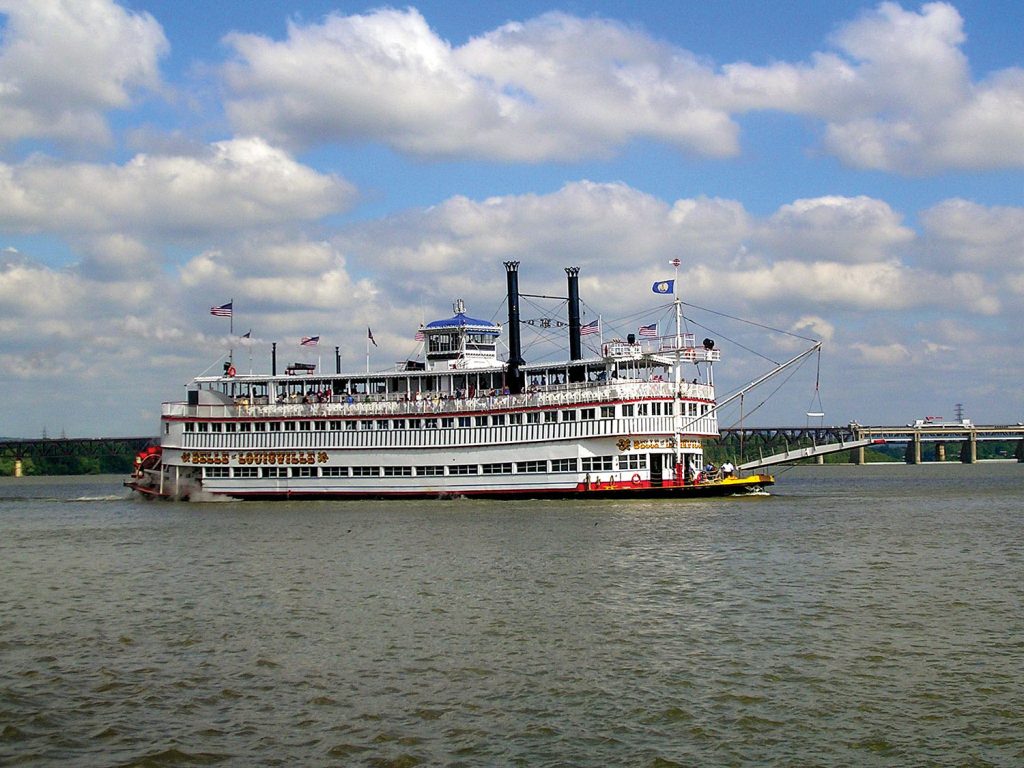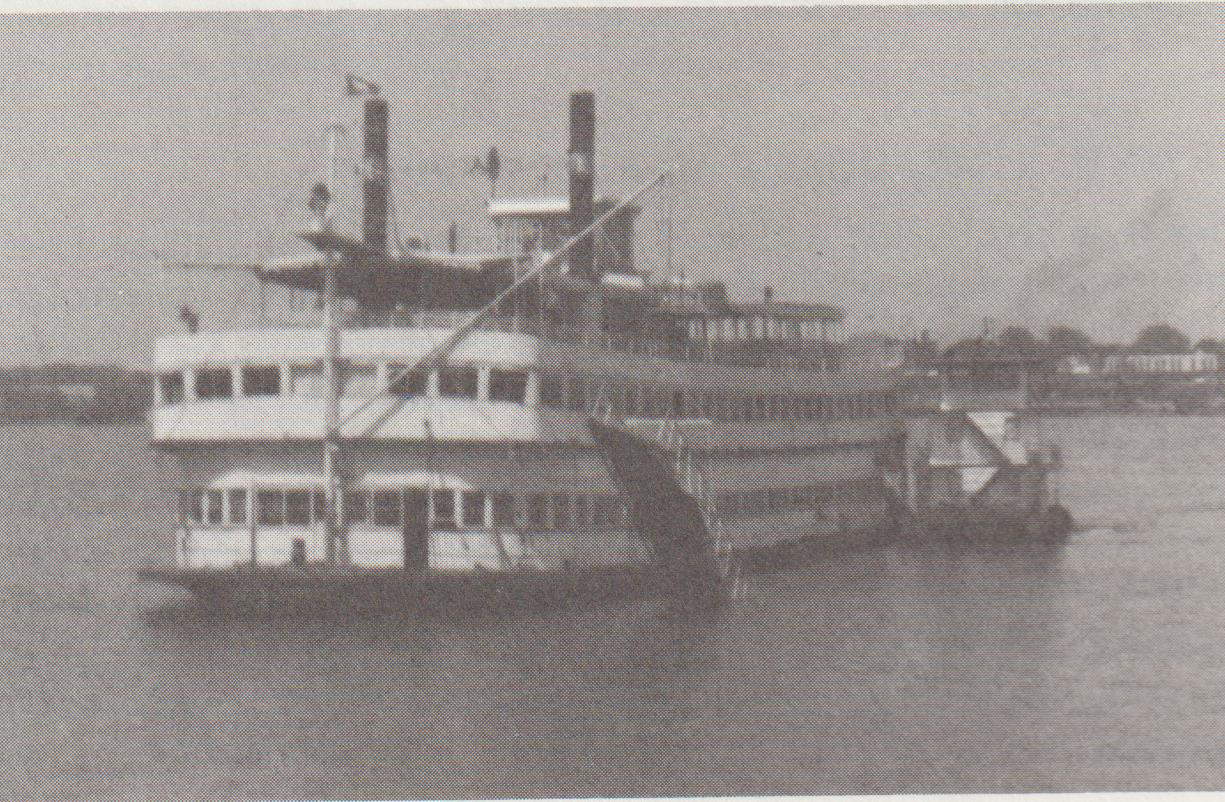The last installment of the Old Boat Column ended with the tramp excursion steamer Avalon awaiting its fate after the owners had declared bankruptcy. Advertisements indicated that the aging vessel was to be sold at auction. The Avalon had been built at Pittsburgh in 1914 by Rees as the Idlewild for the West Memphis Packet Company. The boat had served in the Memphis area as a ferry, excursion boat and day packet until it was sold first to New Orleans interests in 1927 and then to the New St. Louis & Calhoun County Packet Company. It was then an excursion boat in warm weather and a towboat during the colder, off-season months.
In 1947, it was sold to J. Herod Gorsage, Peoria, Ill., and was used exclusively as an excursion boat. The name was changed to Avalon in 1948 to honor a deathbed request of Capt. Ben Winters, and soon after it was sold to Ernst A. Meyer, who formed Steamer Avalon Inc. Meyer had been the traffic manager for the large excursion steamer Island Queen that exploded at Pittsburgh in September 1947, and many former crew members of that boat were employed on the Avalon. The boat became a widely traveled excursion boat, tramping from town to town over virtually the entire Mississippi River system.
Financial difficulties, primarily due to lawsuits following an accident at Emsworth Lock near Pittsburgh in 1958, caused a bankruptcy, and the boat was laid up at Cincinnati following the 1961 season. It was moored underneath the Greene Line wharfboat prior to the auction. According to accounts by Capt. Clarke C. “Doc” Hawley and others, the Avalon was vandalized and plundered of much equipment and furnishings as it sat there.
Most felt that the 47-year-old boat would be sold for scrap, and Hawley himself removed some items to ensure their preservation, including the decorative brass plates from the front of the engine cylinders that were embossed “JAMES REES & SONS CO. PITTSBURG Pa. U.S.A.”
The auction was set for May 24, 1962. During one of the Tall Stacks events at Cincinnati, this writer was privileged to have lunch with C. W. “Bill” Kinzeler Sr. on the Mike Fink floating restaurant. As the Belle of Louisville went by, Kinzeler related to me that he had served as a trustee of the auction sale and described what a mess the boat was in at the time. It was a great surprise when the successful bidder on what was described as a “decrepit steamboat” was the Jefferson County Fiscal Court, Louisville, Ky. The sale price was reported to be $34,000.
While there must have been influence by such Louisville area river aficionados as Capt. C.W. Stoll, Jefferson County Judge Marlow Cook was in office at the time of the auction and bore the brunt of ensuing criticism over the purchase. A politically motivated taxpayer lawsuit over the expenditure of such an “outrageous sum” to buy a “throwback to the Dark Ages of transportation” was immediately filed but failed. Cook figured that the purchase price worked out to roughly six cents per taxpayer, and if individuals complained to him, he gave them six pennies from a jar he kept in his office. He was reelected by a wide margin in 1965 and was later elected to the U.S. Senate.

Alan L. Bates was hired as architect to supervise the restoration of the boat. A committee was formed, and the new name of Belle of Louisville was selected. According to Bates in his book “Belle of Louisville,” Cook informed the committee that regarding the boat, “We are not here to decide whether or not she will run but to decide the best and quickest way to make her run.” After several months of renovations, the addition of the city of Louisville as a partner and the hiring of Capt. Paul. H. Underwood as master, the boat was ready to run again. Hundreds of tons of trash had been hauled off, and hundreds of gallons of fresh paint were applied. The fancy dome on the pilothouse roof, which had been removed during the Avalon days, was replaced, and new smokestacks with feathered tops were installed.
The initial trip for the restored boat, a race with the Delta Queen, took place at Louisville as a pre-Kentucky Derby event on April 30, 1963. Capt. Ernest E. Wagner, the former master of the Avalon, was now in charge of the big Delta Queen. The Belle of Louisville, hampered by water in the fuel, which caused the steam pressure to be low, limped to the finish line far behind the Delta Queen. Still, the race generated much local excitement, and the Belle of Louisville quickly became a darling of the metro area. The race became an annual event.
The boilers from the retired Gordon C. Greene, which had been placed on the Avalon in 1953, were replaced in the mid-1960s with two Brown Fintube boilers (that did not work well). In 1968, the Belle of Louisville was extensively rebuilt at Jeffboat, Jeffersonville, Ind., where a new, longer bow was placed on the hull, increasing the overall length of the boat to 191 feet, 2 inches. During this time, three new Western style boilers, built by the Nooter Corporation, were also installed. In August 1997, the boat partially sank after a vandal manipulated a city water valve to flood the hull. The boat was successfully refloated and refurbished.
The Belle of Louisville, once described as a “decrepit steamboat,” has become one of the most recognized symbols of the city of Louisville. The Rees-built high-pressure engines, 16’s – 6 ½ foot stroke, still propel the boat 110 years after they were placed aboard. Impressively, those engines likely predate the 1914 construction of the vessel by some 20 years. The melodious three chime whistle is also original and has been the voice of the boat throughout the river system all these years. While based at Louisville, it still makes occasional trips to Cincinnati and other nearby places for special happenings.
————
Featured photo caption: The Avalon arriving at Louisville, Ky., in July 1962 following its auction. (Alan Bates photo)




